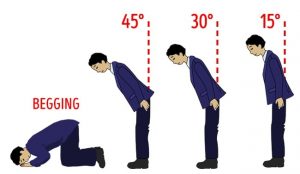Bowing Basics:
The handshake of the east, aka bowing. When I first arrived in Japan I quickly learned that Japanese people are often unaware how to execute a proper hand shake. My hand has been latched onto for 5, 10 or even 15 seconds, aggressively pumped up and down and has been limp fished too many times to count. Turns out shaking hands is a learned skill, bowing is no different.
This is bowing basics!

The When
A firm handshake is great, a firm handshake with the guy next to you at the urinal is… counterproductive. There is a time and a place. Here is our (hopefully complete) list of appropriate bowing situations.
-Greeting or saying goodbye
-Apologizing/thanking someone
-The beginning or ending of a meeting, class or ceremony or some sort
-Asking for a favor
-Welcoming or seeing off a customer
-Giving or receiving a gift
The How
There are levels to this bowing game. Today we are sticking to the fundamentals. This is the standard bow:
-Hinge at the hips
-Maintain a neutral spine
-Look at the other person’s feet
-Keep your hands at your side
-Hold until the other person disengages (entertaining when both don’t wanna give!)
The Dont’s
As is often true, the dont’s will exceed the do’s. There are a few ways to properly bow and an infinite amount of ways to mess it up. Here are some common bowing blunders:
-The Namaste: Ignore what you have seen in Samurai movies and your local Yoga class. The yoga hands together bow is just as strange out here as it is back home.
-Bow or walk, don’t do both: Multi-tasking is efficient but boorish. Bowing should require your full attention.
-Don’t bow from your seat: The same mindset is relevant here, if you are going to bow, you gotta commit to it. Take a stand (up that is).
-Avoid looking at the person as you bow: No, looking at someone you are bowing to does not indicate that you are enemies (I have heard this a few times), it simply looks off. Like it says above, look at the feet.
-Dogeza or kneeling on the floor with your head to the ground: NO. At least in our experience we’ve never seen this except in the movies or extreme exaggeration. I think this mostly died with the ninjas/samurais (or did they..!)
The extra:
Phone bowing:
For advanced bowing proficiency, make sure that you bow while talking on the phone. The person on the phone will be able to sense your sacrifice and appreciate the gesture. A common sight in Japan. For a fun office game, take a tally of your colleagues’s phone bows per conversation and tell them after.
A Japanese standoff:
 Every once in a while two Japanese people wielding a similar social or business pedigree will engage in a Japanese standoff, each trying to outdo the other. Like two stubborn rams battling for polite supremacy. The victor will be determined by bow frequency, duration and depth. It is a mystical sight to behold. Often seen in the streets outside of restaurants, after long business dinners, including multiple sake cups. Banzai!
Every once in a while two Japanese people wielding a similar social or business pedigree will engage in a Japanese standoff, each trying to outdo the other. Like two stubborn rams battling for polite supremacy. The victor will be determined by bow frequency, duration and depth. It is a mystical sight to behold. Often seen in the streets outside of restaurants, after long business dinners, including multiple sake cups. Banzai!
That’s all folks, this was bowing basics. If you have more advance bowing wisdom you would like to share, please leave a comment!

-Bowing practitioner, forging professional relationships.


